
Thawing
I know I’m not supposed to thaw meat on the counter, but how should I thaw meat safely?
Bacteria are dormant in frozen meat, but start to become active as meat thaws. Leaving meat at room temperature for two hours or longer encourages the growth of bacteria and microorganisms that can make you and your family sick. Instead properly thaw frozen meat using one of the methods below.

Steps:
- Move meat from the freezer (0°F or colder) to the refrigerator (40°F or colder).
- Place meat on a plate or in a container to catch meat juices that drip through packaging.
- Store uncooked meat below foods that do not require further cooking, such as raw vegetables and deli meats and cheeses. (Raw meat juices that drip onto these ready-to-eat foods may contaminate them with bacteria and other microorganisms.)
- In general, use meat as soon as possible once thawed. The chart below shows when to use meat once its thawed, assuming the meat stays at 40°F or colder.
|
Meat Type
|
After Thawing, Use Within:
|
|---|---|
|
1-2 days
|
|
Large cuts of meat (roasts, steaks, chops)
|
3-5 days
|
Refreezing:
- Meat thawed in the refrigerator can be refrozen without cooking, although the meat will lose quality with multiple freeze/thaw cycles.
- If meats are thawed using the other methods mentioned on this page, do not refreeze that meat unless fully cooked.
- Do not refreeze any foods left outside the refrigerator longer than 2 hours.

Thawing meat in the microwave is possible and safe, but often results in uneven thawing and usually begins to cook the meat. This method works better with ground meat or small cuts of meat rather than large cuts of meat like roasts or whole chickens.
Steps:
- Remove meat from freezer and remove meat packaging.
- Place meat in a microwave-safe container, preferably glass or ceramic.
- Use your microwave's "defrost" setting or thaw on a low power setting, such as 30% power.
- Once thawed, meat must be finished cooking immediately, either in the microwave or through another method.
Examples:
- Safe: Thaw frozen ground beef and finish cooking in microwave, breaking meat into small pieces while it cooks. Drain excess fat from meat and add cooked meat crumbles to hot pasta sauce.
- Unsafe: Thaw frozen ground beef until soft, add additional ingredients for meatball recipe, and put uncooked meatballs into fridge to cook later.

Meat can be safely thawed in cold - not hot - water. This method is quicker than thawing in the refrigerator, but requires more time management.
Steps:
- Fill a container with cold water (around 70°F).
- Remove meat from freezer.
- Add meat - in leak-proof packaging or bag - to container of water.
- Set a timer for 30 minutes. At 30 minutes, throw out water and refill with new cool water.
- Add meat again and continue these steps of changing water until meat is thawed.
- Once thawed, meat must be finished cooking immediately.
Why Keep in Packaging?
- If meat is thawed outside of packaging, the water may be absorbed in the meat, changing the quality.
- Considering food safety, the bag keeps bacteria or other microorganisms on the meat from getting into the water. Contaminated water may splash onto countertops or other kitchen surfaces.
Time: Larger packages of meat will take longer to thaw than smaller ones. Below are time estimates.
| Meat Amount | Time to Thaw |
|---|---|
| Small packages (1 pound) | ~1 hour |
| Large packages (3- or 4-pounds) | 2-3 hours |
| Whole turkeys | 30 minutes per pound |

Meat can be cooked directly from frozen, depending on the cooking method and type of meat. In all these methods, use a food thermometer to ensure the meat reached a safe internal cooking temperature.
Cooking Method:
- Electric pressure cookers can be used to cook meats directly from frozen. Follow manufacturer cooking time recommendations and use a food thermometer to check the final temperature.
- Stovetop methods like a skillet or saucepan can cook small cuts like frozen fish fillets, ground meat, or stew meat from frozen. Move or flip the meat regularly to ensure more even cooking.
- Dry, hot methods like grills, ovens, or air fryers might allow you to cook meat safely from frozen. Like stovetop methods, use smaller cuts of meat and move the meat regularly for more even cooking. Do not cook large frozen cuts, like a whole turkey, in this method.
- Slow cookers should NOT be used to cook frozen meat. The frozen meat will take longer to reach a safe cooking temperature, which can allow bacteria and other microorganisms to grow to large numbers or produce toxins, which are not destroyed by cooking.
- AskUSDA, United States Department of Agriculture
- The Big Thaw - Safe Defrosting Methods, United States Department of Agriculture, 2013